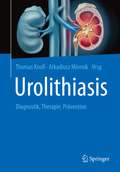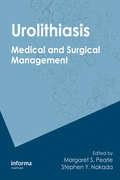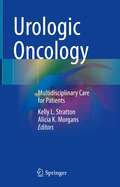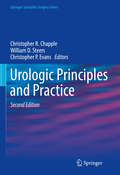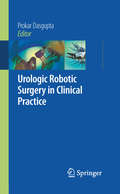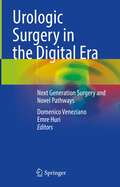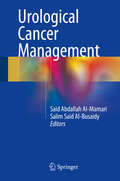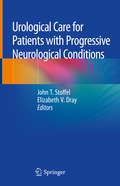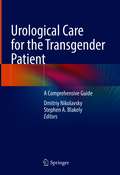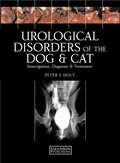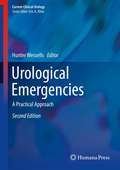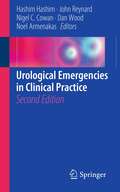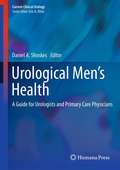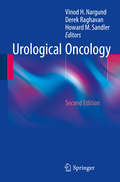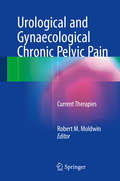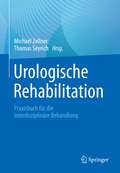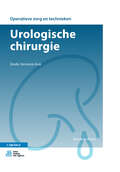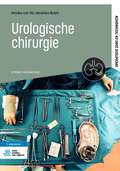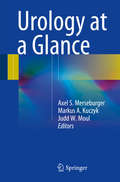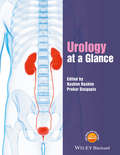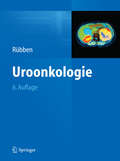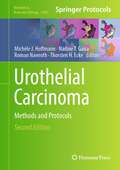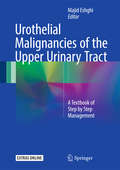- Table View
- List View
Urolithiasis: Diagnostik, Therapie, Prävention
by Thomas Knoll Arkadiusz MiernikEin Buch zum Nachschlagen zu allen Fragen um das vielfältige Krankheitsbild der Harnsteine. Es bildet den aktuellen Stand der Wissenschaft ab mit seinen diagnostischen Verfahren und Therapieoptionen sowie neuen Entwicklungen auf diesem Gebiet. Grundlagen zur Pathogenese und Epidemiologie führen in das Thema ein. Weiterhin werden die Diagnostik und unterschiedliche Therapieverfahren erläutert. Dabei wird auf Harnsteinerkrankungen bei Kindern und Schwangeren gesondert eingegangen. Ein Kapitel widmet sich der metabolischen Diagnostik und Therapie. Tabellen, Übersichten und Algorithmen, erlauben ein schnelles Erfassen der wichtigsten Punkte, und eine strukturierte Diagnostik und Therapie.Für Urologen - niedergelassen oder klinisch tätig - sowie für Weiterbildungsassistenten. Aber auch Nephrologen und Internisten finden hier ein praktisches Nachschlagewerk.
Urolithiasis: Medical and Surgical Management of Stone Disease
by Margaret S Pearle Stephen Y NakadaUrolithiasis, or stone disease occurs in 7% of women and 12% of men at some point, and these statistics are rising. Furthermore, for those who form a stone, the likelihood of a recurrence is nearly 50% within 5 years of initial diagnosis. Therefore, the need for effective, minimally invasive alternatives for stone eradication and prevention is crit
Urologic Oncology: Multidisciplinary Care for Patients
by Kelly L. Stratton Alicia K. MorgansUrologists and medical oncologists have witnessed a rapid growth in systemic therapeutic options for treating genitourinary malignancies that increasingly integrates radiation therapy to primary cancers, nodal beds, and even metastatic sites. The culmination of these advances has been the creation of multidisciplinary teams that expertly provide comprehensive care to patients with urologic cancers. This book provides the framework to create such a multidisciplinary clinical team focused on the treatment of urologic malignancies with representation from urologists, medical oncologists, and additional specialists who work together to provide optimal team-based care. The book integrates advanced systemic therapeutics including immune-based and targeted therapies. Readers gain a better understanding of the benefit of multidisciplinary co-management through specific examples such as hormone sensitive metastatic prostate cancer, neoadjuvant chemotherapy for muscle invasive bladder cancer, and immunotherapy approaches to advanced bladder and kidney cancer. The book also discusses the integration of genomic tumor characterization and personalized medicine into surgical planning, tumor biopsies, and chemo-immunotherapy selection, emphasizing the expansion of new therapeutics for urologic malignancies and the changing definitions of disease progression.Urologic Oncology: Multidisciplinary Care for Patients is a comprehensive resource for urologists, medical oncologists, radiation oncologists, genetic counselors, fellows in urologic oncology and medical oncology, residents in urology and radiation oncology, advanced practice providers, practice managers, and pharmaceutical representatives.
Urologic Principles and Practice (Springer Specialist Surgery Series)
by Christopher R. Chapple William D. Steers Christopher P. EvansThis book fulfils the need for a general urology text primarily urologists in training. It has a novel format by having a clinical chapter always preceded by a scientific foundation chapter. The scientific chapter is geared toward answering questions for boards and understanding pathophysiology, is concise and relevant. The clinical chapter is written around evidence-based medicine and in "how-to" format with algorithms, with reference to AUA & EAU guidelines, well illustrated.
Urologic Robotic Surgery in Clinical Practice
by Prokar Dasgupta Mani Menon J. O. PeabodyRobotics is one of the hottest topics in medicine today, with an international interest that is exponentially growing. The introduction of robotic technology into modern operating theatres has provoked a revolutionary change in the basic surgical approach, with many advantages over traditional open surgical treatment, including faster recovery and a significantly lower risk of surgical trauma. While the benefits of minimally invasive surgery are apparent, the expansion of laparoscopic surgery throughout the field has been relatively slow due to the steep learning curve and the level of practice and specialism required to perform such procedures. Although revolutionary upon conception, standard laparoscopy involves the surgeon working from monitors with no depth perception and also with a surgical motion that is counter-intuitive. The introduction of robotic technology however, has surpassed the traditional laparoscopic approach by providing full three dimensional vision, intuitive motion and wristed instrumentation with motion scaling. These dramatic innovations have broadened the scope of surgeons that can now perform complex laparoscopy, and while still in its infancy, robotic assisted surgery has begun to infiltrate all fields of surgery. However, while the practical adoption of the techniques and procedures has increased over the last 5 years, the educational resources have not, leaving the only available learning tools as videos, case observation and proctorships. There is therefore a severe market void for such a publication as this, with steadily growing sales around the world of robotic surgical systems. A compact book, overseen by such a respected figure and featuring contributions from the field leaders, is sure to be very successful within the next few years.
Urologic Surgery in the Digital Era: Next Generation Surgery and Novel Pathways
by Emre Huri Domenico VenezianoThis book provides a practical guide to the use of the latest applicable surgical procedures and present novel pathways. It details how to utilize a range of techniques including three-dimensional (3D) laparoscopy and those that require robotic assistance. Guidance is also contained on innovative tools including confocal laser endomicroscopy along with the application of biomaterials, artificial intelligence and other exponential technologies, enabling the reader to systematically develop a thorough understanding of these methodologies. Urologic Surgery in the Digital Era: Next Generation Surgery and Novel Pathways systematically reviews the application of the latest surgical techniques and potential future developments in urology. Therefore, it is a critical resource for all practicing and trainee urological surgeons.
Urological Cancer Management
by Said Abdallah Al-Mamari Salim Said Al-BusaidyThe authors aim to provide essential information on various clinical cases on urological cancers. The main messages are well referenced and the texts phrasing is written in a simple and user-friendly style. The book also contains summarizing tables and high quality original pictures. Several expert panels (American Urologists Association, European Association of Urologists, Association Française des Urologues, etc) are proposing guidelines aiming at providing detailed recommendations to the Urologists facing difficult urological scenarios and no significant discordance exist between them since they are all based on the existing published studies dealing with different aspects of the urological cancers.
Urological Care for Patients with Progressive Neurological Conditions
by John T. Stoffel Elizabeth V. DrayThis text creates a framework for the integration of urological care into the long-term management of patients with progressive neurological conditions. It begins with a general review of the neuroanatomy and physiology of the bladder, followed by a discussion of common techniques for evaluating bladder and upper tract function, and the general principles of bladder management in patients with neurogenic bladder disease. Section II narrows the scope of each chapter to focus on specific neurological disorders such as Parkinson's Disease, Alzheimer's Disease, Dementia, and Cerebral Palsy. Each chapter begins with a brief synopsis of the neurologic basis of each disease, followed by its most common urologic manifestations, specific recommendations for urologic care in each disease state, and finally a recommended pathway for integrated long-term care of these patients based on available evidence and expert opinion. The final section of the text reviews the generalized care of patients with advanced disease, including palliative and end of life options, focusing on urologic interventions. Urological Care for Patients with Progressive Neurological Conditions will be an invaluable resource for urologists, neurologists, and all health care providers treating patients with neurological diseases.
Urological Care for the Transgender Patient: A Comprehensive Guide
by Dmitriy Nikolavsky Stephen A. BlakelyThis book is designed to familiarize general urologists with the care of transgender and gender non-conforming individuals. Written by experts in reconstructive urology, it characterizes the process of gender affirmation and explains the surgical anatomy of both feminizing and masculinizing gender-affirming procedures including vaginoplasty, orchiectomy, hysterectomy, vaginectomy, phalloplasty, metoidioplasty, and prosthetics. Guiding the clinician in identification of immediate and long-term risks of gender-affirming surgery, it instructs clinicians in endocrinological care, options for fertility preservation, evaluation of malignancies after hormonal therapy, appropriate postsurgical follow-up, and the management of common complications involving urethral stricture, fistula, neo-vaginal stenosis, and incontinence. Urological Care for the Transgender Patient: A Comprehensive Guide is a necessary tool to prepare urological clinics and clinicians in serving the growing population of transgender patients presenting at various stages of their transformation.
Urological Disorders of the Dog and Cat: Investigation, Diagnosis, Treatment
by Peter Holt Alasdair Hotson-MooreThis book provides veterinary practitioners and trainees with a concise, systematic guide to urological disorders affecting dogs and cats. The author focuses first on assessment of the patient and the main investigative techniques to reach a diagnosis. He then deals with the differential diagnosis, causes and treatment of conditions ranging from pr
Urological Emergencies
by Hunter WessellsUrological Emergencies: A Practical Approach, Second Edition provides a concise, evidence based review of common urgent and emergent urological conditions in children and adults. Descriptions of the appropriate diagnostic and therapeutic considerations on topics of traumatic, infectious, obstructive, hemorrhagic, iatrogenic, vascular and congenital urological emergencies in adults and children are provided. The text is organized by pathophysiology rather than organ system, allowing the reader to develop approaches to the care of patients with acute urological conditions based on mechanism of disease. Relevant pathophysiological background and epidemiology are reviewed, necessary diagnostic testing recommended, and detailed medical, surgical and endourological management approaches have been provided. All chapters incorporate published guidelines and best practice recommendations from appropriate organizations including the American Urological Association, the Centers for Disease Control and Prevention, and various International Consultations on Urological Diseases. New or significantly revised chapters in each of the subsections address innovations in trauma care and prevention, new strategies in management of kidney stones, and special care needs of children with acute urological problems. Urological Emergencies: A Practical Approach, Second Edition is of great value to practicing urologists, urology residents, emergency medicine trainees and practitioners, and primary care providers including MD's, PA's, and NP's without immediate access to urological consultation.
Urological Emergencies In Clinical Practice
by Dan Wood Hashim Hashim John Reynard Nigel C. Cowan Noel ArmenakasUrological Emergencies in Clinical Practice, Second Edition, is a well-researched pocket book that provides a comprehensive summary of urological emergencies and their management, in a form that is concise, relevant to the target audience and readily available. While the description of each emergency condition is comprehensive, the emphasis is on the practical approach to the conditions which are likely to be encountered. Since the first edition, there have been new guidelines published by the European Association of Urology which are incorporated in the new edition of this book. Furthermore this edition contains a chapter on pediatric urological emergencies. For the doctor or nurse expected to provide the initial assessment and management of a condition with which he or she has had very limited experience, Urological Emergencies in Clinical Practice, Second Edition will provide an invaluable source of information and advice.
Urological Men’s Health
by Daniel A. ShoskesUrological Men's Health: A Guide for Urologists and Primary Care Physicians covers the major urologic conditions that have an impact on the health and well being of the adult male. It opens with an overview of general men's preventative health, as practiced by a world leading Executive Health center. The volume covers the major genitourinary malignancies and addresses the latest controversies in screening and treatment selection. This is followed by coverage of the conditions that don't shorten life but have major impact on quality of life and health care expenditure: BPH, urinary incontinence, infertility, urethral strictures, erectile dysfunction, urinary tract infections and chronic pelvic pain. Also included are chapters on herbal and complementary therapy, psychological and spousal support in urologic illness and the links between genitourinary disease and general vascular endothelial dysfunction. Urological Men's Health: A Guide for Urologists and Primary Care Physicians will be of great value to Urologists, Internists, General Practitioners and the residents and fellows who train within these specialties.
Urological Oncology
by Derek Raghavan Vinod H. Nargund Howard M. SandlerAs a professional resource for all doctors, oncologists and urologists involved in the care of uro-oncology patients, this book puts emphasis on developing advanced practice with in-depth discussions to support evidence based, patient focused care. Urological Oncology, Second Edition offers an updated multi-disciplinary and multi professional approach to the assessment, diagnosis, treatment and follow-up care of patients being investigated and treated for urological malignancies. Mainly aimed at oncologists and urologists, it is also useful for general physicians as well as trainee nurses and nurse practitioners in urology / urological oncology.
Urological and Gynaecological Chronic Pelvic Pain
by Robert M. MoldwinThis text is designed for those clinicians who feel comfortable diagnosing these illnesses and wish to enhance their knowledge base and skill set regarding treatment options. Referrals for pelvic pain are common in urological and gynaecological practice; and may lead to varied diagnoses such as interstitial cystitis/bladder pain syndrome, chronic prostatitis/chronic pelvic pain syndrome, pelvic floor dysfunction, chronic orchialgia, and vulvodynia. To make matters more complex, each of these conditions is frequently associated by co-morbidities. The text is unique in being organized by the multiple and multifaceted therapies that are available, rather than by specific disorders. The text is richly illustrated with multiple diagrams, figures, and tables, making it the "go to" and "how to" reference for patient treatment.
Urologie
by J.L.H.R. Bosch C. H. BangmaKlachten van de urinewegen en de voortplantingsorganen komen voor in elk levensstadium. Urologische aspecten van de menselijke fysiologie zijn van belang in verscheidene kritische processen tijdens de puberteit, de bevruchting, de zwangerschap en het senium, waarin men ernaar streeft gezond oud te worden. De ontwikkelingen in het vak urologie gaan snel. Daarom is actuele kennis over de werking en de afwijkingen van de tractus urogenitalis essentieel voor elke arts. In deze editie van Leerboek urologie zijn de nieuwste ontwikkelingen in de diagnostiek en therapie opgenomen. De meest voorkomende urologische klachten vormen de basis, net als in vorige drukken van dit leerboek. Hierbij is steeds de relatie met de anatomie en de (patho)fysiologie aangegeven. Ook de recente technologische ontwikkelingen komen aan de orde. Moleculaire achtergronden gaan immers een belangrijke plaats innemen in de diagnostiek van morgen. In compacte tekst met overzichtelijke schema's geeft dit handzame boek een heldere weergave van de stand van het wetenschappelijke onderzoek. Aanschaf van het Leerboek urologie biedt de lezer toegang tot de website extras. bsl. nl/urologie met extra materiaal, zoals instructiefilms over het urologisch onderzoek en katheterisatie en een interactieve leermodule over het urodynamisch onderzoek. Ook bevat de website de volledige inhoud van dit boek, waardoor het overal online te raadplegen en snel te doorzoeken is. Leerboek urologie is onmisbaar voor studenten geneeskunde en basisartsen en vormt daarnaast een handig naslagwerk voor specialisten en huisartsen.
Urologie in Österreich: Von Wien in die Welt
by Shahrokh F. Shariat Thorsten Halling Friedrich H. MollÖsterreichische Urologie und internationale Netzwerke vom 19. bis zum 21. Jahrhundert Ausgehend von der akademischen Etablierung einer Spezialdisziplin, die sich mit der modernen Krankenhausmedizin im 19. Jahrhundert etablierte, möchte die Buchpublikation erstmals zentrale Entwicklungslinien der österreichischen Urologie und ihre besonderen internationale Vernetzung nachzeichnen. Aufbauend auf den Arbeiten Neuburgers und Leskys wird der Versuch unternommen, neue wissenschaftliche Ergebnisse einer breiten Leserschaft, die alle an der Urologie und Medizingeschichte interessierte einschließt, näher zu bringen. Im Mittelpunkt stehen dabei neben prägenden Akteuren, zentrale Institutionen, die bisher noch nicht im Forschungsfokus lagen, Fachgesellschaften und konstituierende Themen. Konzeptionell und methodisch folgen die Einzelbeträge aktuellen Fragestellungen der Wissenschaftsgeschichte, wie z.B. Professionalisierung, Netzwerkanalyse, Anerkennungskulturen in den Wissenschaften, Exilforschung, Sexualforschung, Wissenskulturen und dem fachkulturelles Gedächtnis. Hierbei wird auch ein Schwerpunkt für die Zeit zwischen 1938-1945 und die besondere Rolle Wiens und Österreichs im Wissensaustausch mit Osteuropa gesetzt.
Urologische Rehabilitation: Praxisbuch für die interdisziplinäre Behandlung
by Michael Zellner Thomas SeyrichObwohl sich zahlreiche Fachgruppen als auch die Deutsche Rentenversicherung und die Krankenkassen an der Rehabilitation von Patienten mit urologischen und uro-onkologischen Erkrankungen beteiligen, existiert für diese Patienten kein standardisiertes Rehabilitationsprogramm. Zurzeit ist es den Rehakliniken noch weitgehend selbst überlassen, welche Beratungsangebote und Leistungen sie zur Behandlung von charakteristischen postinterventionellen Beschwerden und sozialen Situationen unabhängig von vorgehaltener fachspezifischer personeller und apparativer Infrastruktur und Kompetenz anbieten.Dieses Buch verbindet Praxis- und Fachwissen aus der Rehabilitation von urologisch Erkrankten und stellt es interessierten Kollegen zur Verfügung.Dazu zählt sowohl die Rehabilitation von Störungen der Blasenfunktion als auch von Störungen der Sexualfunktion. Weiterhin werden die Maßnahmen aufgrund der spezifischen Veränderungen nach einer Zystektomie mit den verschiedenen Formen der Harnableitung besprochen. Auch Komplikationen und Folgeschäden nach invasiver Intervention, z.B. einer Operation wie z.B. Lymphödeme im Bein- und unteren Rumpfbereich sollten mit behandelt werden. Für die uro-onkologische Rehabilitation werden sowohl bewegungstherapeutische Maßnahmen als auch psychooonkologische Angebote erläutert. Aber auch flankierende Themen wie Ernährung und eine gesunde Lebensweise sind wichtige Bausteine für eine interdisziplinäre Rehabilitation dieser Patientengruppe. Ein kompaktes Praxisbuch für Ärzte aller Fachrichtungen, die Patienten mit urologischen Erkrankungen in der Rehabilitation bestmöglich versorgen möchten.
Urologische chirurgie (Operatieve zorg en technieken)
by Hendries BoeleDit leerboek geeft aankomende operatieassistenten een helder beeld van operatietechnieken binnen de urologische chirurgie. Ook geeft het achtergrondinformatie bij verschillende ziektebeelden. Daardoor is het ook zeer geschikt als naslagwerk voor andere beroepsgroepen in de gezondheidszorg. Urologische chirurgie is onderdeel van de reeks Operatieve Zorg en Technieken. Die bestaat uit het basisboek en uit een aantal vervolgdelen, waarin de verschillende subspecialismen van de chirurgie worden behandeld. Ieder hoofdstuk begint met een inleiding, gevolgd door een uitwerking van de pre-, per- en postoperatieve fase van de operatie. De opstelling van het operatieteam wordt per operatiebeschrijving verduidelijkt door een afbeelding. Achter in het boek staat altijd een selectie van veelvoorkomend specifiek instrumentarium. De reeks ‘Operatieve Zorg en Technieken’ benadert de beroepsuitoefening van de operatieassistent zo dicht mogelijk. De talrijke afbeeldingen onderbouwen deze benadering. Deze editie van Urologische chirurgie is aangepast aan de meest recente ontwikkelingen in het specialisme. Door de enigszins gewijzigde opzet is deze uitgave overzichtelijker geworden. Ook is er een aantal nieuwe technieken opgenomen, zoals de robotgeassisteerde radicale cystectomie (RARC), de endoscopische transvesicale adenomectomie van de prostaat (ETAP) en de Urolift-procedure.
Urologische chirurgie (Operatieve zorg en technieken)
by Hendries Boele Maaike van TolDit leerboek biedt inzicht in de theoretische en praktische aspecten van urologische operaties. Daarnaast wordt er in dit boek aandacht besteed aan de anatomie van de verschillende organen die behandeld worden binnen het urologische vakgebied en wordt er stilgestaan bij verschillende ziektebeelden.Het boek begint met een uitgebreid algemeen deel waarin een aantal algemene richtlijnen en verschillende specifieke benodigdheden en apparatuur worden besproken. De daaropvolgende delen behandelen de diverse operaties aan de nier, ureter, blaas, prostaat, urethra en de uitwendige geslachtsorganen van de man. Ieder deel begint met een beschrijving van de anatomie en de pathologie die horen bij het orgaan dat centraal staat in dat deel. De volgorde van de ingrepen die aan bod komen loopt van laag complex naar hoog complex. Voor een overzichtelijke beschrijving van de operatietechnieken worden deze, net als de andere boeken uit de reeks Operatieve zorg en technieken, opgedeeld in een preoperatieve, een peroperatieve en een postoperatieve fase.In deze editie van Urologische chirurgie is meer aandacht gekomen voor de oncologischeziektebeelden binnen het urologische vakgebied en de behandeling daarvan. Daarnaast wordt er stilgestaan bij incontinentie bij mannelijke patiënten en ook de behandeling van impotentie komt uitgebreid aan bod. In deze uitgave worden tevens een aantal ingrepen beschreven waarbij het gebruik van een operatierobot centraal staat, aangezien deze techniek inmiddels niet meer weg te denken is binnen de urologie.De reeks ‘Operatieve Zorg en Technieken’ is bestemd voor de opleiding tot operatieassistent.Naast het basisboek bestaat de reeks uit een aantal vervolgdelen, waarin de verschillende chirurgische specialismen worden behandeld. Deze reeks benadert de beroepsuitoefening van de operatieassistent zo dicht mogelijk, waarbij de gebruikte illustraties en afbeeldingen deze benadering ondersteunen.
Urology at a Glance
by Axel S. Merseburger Markus A. Kuczyk Judd W. MoulUrology at a Glance is a concise, practical guide to diagnostic and therapeutic decision making. The book is divided into two parts. The first focuses on the pathway from symptom to diagnosis and covers the full range of symptoms commonly encountered by the urologist. Any particular symptom can be located within a matter of seconds and in each case differential diagnosis is explained with the aid of a flow chart. The second part of the book is devoted to the pathway from diagnosis to therapy, with each short chapter devoted to a specific diagnosis. Basic information is provided on the disease in question, along with an outline of state of the art treatment options and possible complications. Again, flow charts are used to help the reader to reach the correct therapeutic decision in different circumstances. Numerous high-definition photographs and illustrations are also included. This book will be a great asset for urologists and practitioners in related disciplines.
Urology at a Glance
by Prokar Dasgupta Hashim HashimFollowing the undergraduate curriculum set by the British Association of Urological Surgeons, Urology at a Glance offers practical advice on diagnosis and management of one of the most rapidly developing medical specialties. Building on basic science, the book provides an overview of clinical approaches to assist the medical student or junior doctor on rotation, as well as looking at practical procedures and specific details of the most commonly encountered urological disorders. Vibrantly illustrated and containing common clinical scenarios, Urology at a Glance provides all the information and latest guidelines needed for a medical student or junior doctor to excel in this field.
Uroonkologie
by Herbert RübbenDas Standardwerk der urologischen Onkologie aktualisiert in 6. Auflage!Die „Uroonkologie" bietet dem Leser vollständige und umfassende Information zu allen Bereichen des Themas:alle Grundlagen für eine erfolgreiche Therapie von Molekularbiologie über Studienplanung bis zu alternativen Therapieansätzen,alle Details zur Diagnostik, Indikationen, Durchführung und Ergebnis der verschiedenen Therapieansätze aller urologischen Tumorerkrankungen.Zusammenfassende Bewertung der Therapien am Ende jedes Kapitels.NEU: Neugliederung des Inhalts zur besseren Orientierung mit neuen und komplett überarbeiteten Kapiteln zu Themen wie:· Inkontinente- und Rektale Harnableitung· Komplikationsmanagement bei Immun- und Chemotherapie· Sexualität und Krebs· PharmaökonomieEine praxisnahe, klare Sprache, viele Tabellen und instruktive Abbildungen erleichtern das Lesen. Zahlreiche Therapie- und Nachsorgeschemata sorgen für eine schnelle Orientierung und ermöglichen die direkte Umsetzung in die tägliche Praxis.Als Autoren wirken die anerkannten deutschsprachigen Experten zum Thema.Rübben: Uroonkologie - Das Buch, an dem kein onkologisch tätiger Urologe vorbeikommt!
Urothelial Carcinoma: Methods and Protocols (Methods in Molecular Biology #2684)
by Michèle J. Hoffmann Nadine T. Gaisa Roman Nawroth Thorsten H. EckeThis fully updated volume explores recently improved avenues to study urothelial carcinomas. Beginning with several novel chapters on molecular characterization and urothelial carcinogenesis, the book continues with sections on cellular and animal models, biomarkers, and approaches for targeted therapy. Written for the highly successful Methods in Molecular Biology series, chapters include introductions to their respective topics, lists of the necessary materials and reagents, step-by-step and readily reproducible laboratory protocols, as well as tips on troubleshooting and avoiding known pitfalls. Authoritative and practical, Urothelial Carcinoma: Methods and Protocols, Second Edition serves as a valuable resource to further increase our knowledge on urothelial carcinoma and also to aid research on numerous other cancers.
Urothelial Malignancies of the Upper Urinary Tract: A Textbook of Step by Step Management
by Majid EshghiThis book addresses all aspects of upper urinary tract urothelial tumors. It represents the first dedicated text to address solely the symptomatology, diagnostic tools, staging, radical and conservative treatment of these tumors. It describes all new diagnostic tools ranging from radiologic to endoscopic and biopsy techniques, antegrade and retrograde methods of conservative endoscopic resection of tumors. Treatment is described in several chapters including open segmental resection, radical total nephroureterectomy, laparoscopic and robotic assisted procedures. Minimally invasive endoscopic approaches are detailed including ureterscopic retrograde and percutaneous antegrade techniques for larger lesions. Intracavitary chemotherapy and immunotherapy and palliative treatments is also covered. The text is richly illustrated and contains links to video clips for visual impact. Chapters also reflect the current technology and new trends on the horizon.
